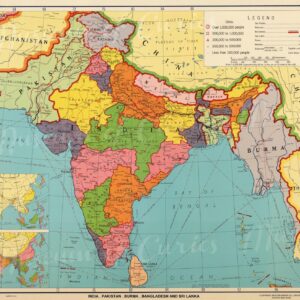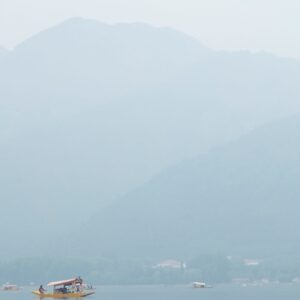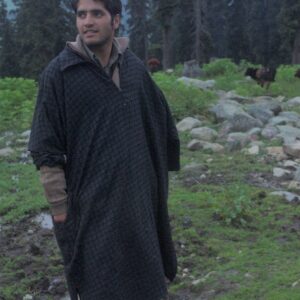Whenever I find myself in front of a map, I almost always look for a few places first. The presence of certain countries can tell me how old the map is. Many maps I find in classrooms in my school still lack South Sudan. Newer maps may have replaced Swaziland with its new name, eSwatini.
The spot I usually look for first is Kashmir, which lies between India, China, and Pakistan.

My shower curtain has a gigantic map on it and I usually find myself spending way too much time with water pouring over my face plotting my next trip. That map has taken the most neutral stance on the territory that I have ever noticed: it was just a gray blob. Sometimes the entire territory is given to India, while other maps present several dotted lines giving power of sections to all three nations. It would be difficult for a map to keep up with which portion of Kashmir is owned by which country because it changes so frequently. Four wars between Pakistan and India have torn apart the people of the region, who have never been given a chance to vote on which nation they would like to belong to. Even now, reports of soldiers on the border attacking each other are common.
When I found myself lost in the confusion and heat of New Delhi in the summer, I decided that I needed the wide-open skies and cool mountain air of Kashmir. To get there I did something I don’t normally do and walked into a travel agency. I told them that all I wanted was a bus ticket up there, but they pushed me to book one of their hotels. They told me Kashmir was dangerous and that I needed someone they could trust there. I didn’t really trust them any more than anyone else, but they wore me down.
During the forty (yeah, that’s right, forty!) hour bus ride we stopped twice for prolonged periods of time. Once was for some bus maintenance. (It turned out to be an entire axle replacement!) The second time was in the mountains of Kashmir. I followed everyone else off the bus to stretch my legs and finally breathed in the cool mountain air I was hoping for. When I turned and asked someone next to me how long we would be stopped for, he shrugged and replied, “Could be a few minutes. Maybe hours. Maybe days.” Luckily, it was only a few minutes.

The first city I went to was Srinagar. I’m not quite sure what about that city appealed to me at first. The Himalayan mountains surely called to me, but more so perhaps was the allure of a section of the world nearly cut off from everywhere else. A place without a country. The hotel I was forced into agreeing to was a houseboat on Dal Lake. Houseboats are a common attraction in Srinagar. The hotel gave me a guide, but he was more of a babysitter. He paddled me to the mainland, told me where to eat and what to see. There were no other tourists on the houseboat. It was just me and my “guide.” When I tried to leave, they told me I wanted to stay another week. I did not. Luckily a bout I had with some food poisoning made them lose interest in me and I found myself a day later stranded on the mainland walking to a hotel. The next few days I explored ancient streets, ate my way through markets, and walked back to my hotel at night to the Call to Prayer. I found the people to be friendly (except for my houseboat captors). One hotel owner asked me to join him for tea and we talked through the evening. Another man took me into his internet café, which was just a room in the front of his home, to chat and then ordered his son to take me to a few must see mosques.
In many ways, it resembled India as I thought of it. While most of the people were Muslim, as opposed to Hindu, I ate what I recognize as Indian food — and of course, some things I had never seen before or since. The streets were still as chaotic as I found them to be in Delhi, but at least here they were much more manageable. Kashmir has a much less dense population than the rest of India, and this made travelling a little easier.
I even hiked high in the mountains with a group of cow herders for a few nights. They spoke little English, but we bonded over wood chopping and I did my best to learn cricket. A few nights in a barn, a day hike to a mountaintop lake, and another bout with illness, this time altitude sickness, and I was ready to move on.

The next day, back in Srinagar, I asked the people at the hotel to help me get to Leh, in the Ladakh region. This portion of Kashmir lies on the border of China. One of them brought me to a busy bus depot and this time I squished in the back of a van. With little room to move and no room for my head or legs, we sped through the Himalayas. The people in my bus were clearly ethnically different than the people in the city we left behind. These men — all of the passengers were men — looked more Tibetan or Nepalese. And they dressed differently too. They wore tight jeans, sneakers, and hoodies, as opposed to the loose clothing or slacks and button-down shirts I had seen people wear for the past week and a half. We were clearly going to an entirely different part of the world, while never leaving the same region.

The van raced along the mountains, sometimes uncomfortably close to the edge of a very steep cliff. We stopped for lunch in Dras, the “gateway to Ladakh”. At close to 11,000 feet elevation, it’s the “second coldest inhabited city in the world”. By nightfall we were there.
Nothing could have prepared me for the beauty of Leh. Snow-capped mountains stretched in all directions. The city looked more like a trendy ski resort than an ancient mountain town. Buddhist monks walked along narrow streets draped in prayer flags. The people were friendly, relaxed, and warm.

Stores boasted clean water to fill up old water bottles, rather than using a new plastic bottle each time as is customary in much of Asia. It was a town for hikers and mountain climbers. They even had an ice hockey team.
I took a day trip to visit a few beautiful Buddhist monasteries carved into the sides of mountains far off in what seemed like a completely isolated countryside. The only thing that lay between us and the mountains was the silence that enveloped us.
I spent another day white-water rafting on the Zanskar river. It was hard to remember that I was in India, not Colorado.
If I had any regrets it was that I didn’t spend more time there. A week-long trek in the Ladakh region can reveal to you ancient groups of people living their lives as they have for hundreds, if not thousands, of years.
Kashmir occupies an ambiguous spot on a map. To group its distinct parts together though, as one region in one country, is nearly impossible. Kashmir provides many of its own sights and sounds unique to the rest of India; unique even to its own varied corners. And no map, however detailed, can start to convey its beauty.












